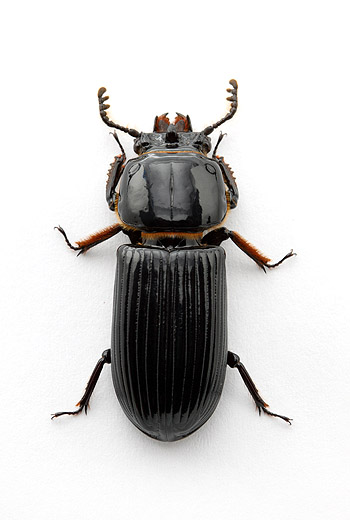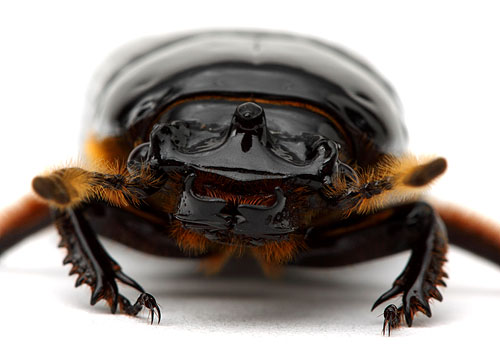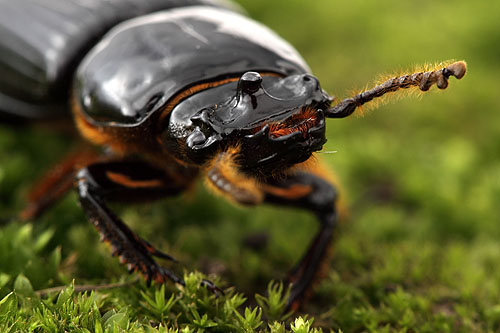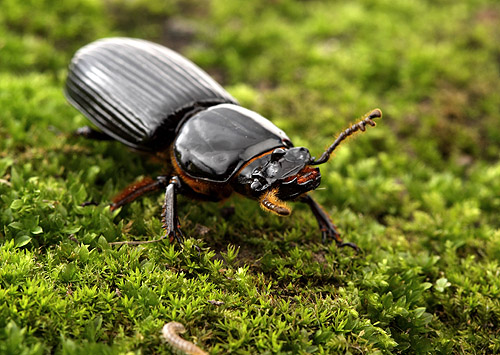
Odontotaenius disjunctus, the horned passalus
Friday Beetle Blogging returns this week with portraits of an unusually social beetle. The horned passalus Odontotaenius disjunctus lives in groups in rotting logs, where adults practice a form of parental care. I photographed this individual last weekend in southern Illinois, but the species ranges from the tropical forests of Central and South America Texas to as far north as New York.



photo details (all photos): Canon 100 mm f2.8 macro lens on a Canon EOS 50D
ISO 160, f/10-13, 1/125 sec, indirect strobe diffused in a white box

These images are mesmerizing... Great looking insect, too; I rather like the two-tone color scheme and that glossy thorax.
I agree. Beautiful photos. One thing should be mentioned. This species is only found in the eastern U.S. and Canada; it does not occur in Latinamerica, though many other species do. We have at least 84 species here in Guatemala (versus probably only 3 in the U.S.!). A couple of them have a bifurcated horn! Some are as long as the palm of your hand!
Thanks for the correction, Jack. Do the different species in the tropics live in the wood of different kinds of trees? Or are they dividing up the resources in some other way?
No, really. Did you clean this guy up for his 15 minutes of fame, or is he naturally so tidy? Glossy or matte, the beetles I find in my desert yard are always dusty and crud-encrusted. What a fabulous dude!
Passalids are great beetles. As well as an interesting subsocial lifestyle, squeeking communications, and large, shiny beetleness, passalids host over 20 families of symbiotic mites, including giants in the genus Megisthanus - with body lengths of 5 mm or so in some Queensland species (the largest mites known in the Mesostigmata).
Mostly what these mites are doing on the beetles is more than a bit mysterious, but probably a bit of everything. Megisthanus seem to be using the beetles as a mating platform - only adult mites are found on the beetles, usually the beetle's mites are highly female-biased, only 1-2 males can be found, and males are larger than females (very unusual in the Mesostigmata where males are usually half the mass of the females).
In Queensland's rainforests, it isn't uncommon to find 2-3 species of passalids (usually in different genera) living together and often in the same log. If they are partitioning the log species, it was never obvious to me. However, I always thought I could recognize a log with a good probability of having a passalid from its moist, punky consistency. I remember having the same opinion about the logs that Odontotaenius disjunctus (at that time in Popilius) used, we I was a bug student in Maryland.
Perhaps the US is a bit challenged in passalid diversity, but alas and alack, Canada is completely deficient in passalids. Now I feel hopelessly homesick for Queensland. Thanks Alex.
Wow. I would love to see one of those giant Megisthanus mites. Must be like having a pair of rabbits in heat running over you body! Seems to me that I recall as a student in Florida one of my fellow students injected some radioactive isotope in a passalid and later detected it in a Megisthanus.....
Actually, passalids DO get into Canada, in southern Ontario and even south of Winnipeg! But only O. disjunctus. I have been playing with Klinckowstroemiidae mites, cute little buggers that are Neotropically distributed.
There doesn´t seem to be much specificity in log hosts for passalids, though only a few species inhabit pines. O. disjunctus can be found rarely in pines. It prefers oaks and other angiosperms 2 to 3 years dead. More than one species can inhabit a long, up to 10 in one citation from Brazil. The most I have found is 5. Almost never in same tunnel system....when I did find them in the same system they were far separated by disused parts of the tunnels that had been packed with frass. Some species prefer living under bark, others in the heartwood. A few species have other habitats: leaf-cutter ant detritus chambers, termite nests, epiphytic plant roots or rhizomes.
Hey Jack,
Thanks for correcting me on the disjunctus distribution before I shot my mouth off in front of a Canadian coleopterophile (although I'm not sure if Albertans consider anything east of Saskatoon as Canada). Nevertheless, the Entomological Society of Canada AGM is in Winnipeg next month. Any passalid sites near enough to town to go Megisthanus hunting?
I've never had a chance to study Klincks, but the related Fedrizziidae have bizarre mop-like processes on their chelicerae that they swipe back and forth on the surface of the beetle. Megisthanus have fearsome looking cheliceral teeth, but don't bite the beetles. They also have membranous processes that may be able to take up beetle secretions (see Fig. 12.19D, p. 186 in the 3rd edition of the Manual of Acarology).
The adults of these families are said to be 'paraphagic' on the beetles - that means no one knows what they are feeding on, but perhaps secretions. Owen Seeman at the Queensland Museum and others have worked out the rest of the life history of these mites - immature stages are predators of nematodes and small arthropods and also scavengers in the beetle galleries.
I think the only family of insects that can rival the passalids for the number of families of associated mites is the Formicidae. And even among the ants, most of what these mites are doing is not very clear.
Hey, Dave,
Wish I could help you in your Megisthanus hunt. I don´t know the area. Someone from the area told me about passalids getting up there in patches of deciduous forest.
Is there anyone working on Megisthanus now? I have lots of them here, but don´t know anything about their taxonomy. For that matter, anyone working on passalid mites anywhere? (I know of a guy in Mexico working on Klincks).
That is a very shiny beetle. Did you wash and wax him before the photo shoot?
Your identification of this beetle as Odontotaenius disjunctus made me remember that I'd taken several shots of what I called a patent leather beetle. Apparently I'm wrong. Please take a look and tell me what you think. Your shots are great, by the way. The first shot in your post is magnificent.
Thanks
Doug
http://www.flickr.com/photos/blankenshipimages/3804155112/in/set-721576…